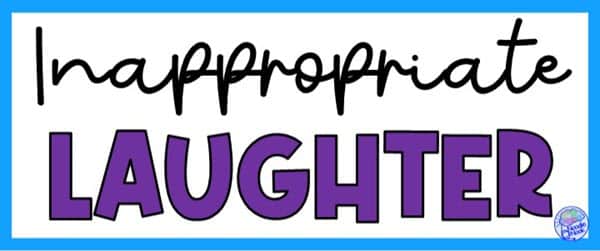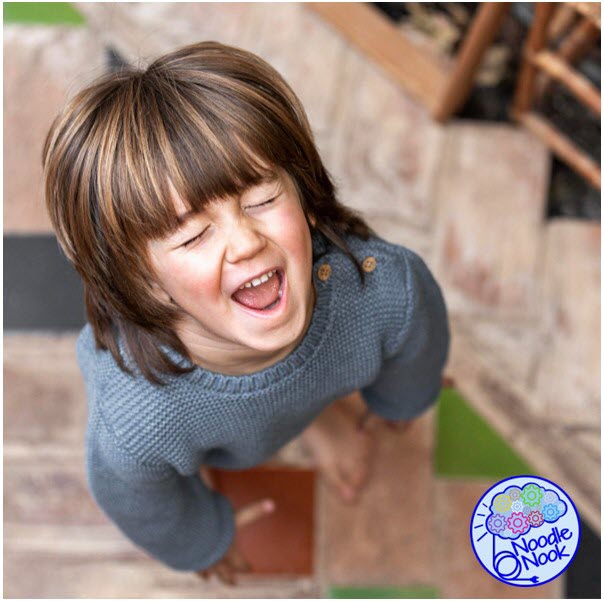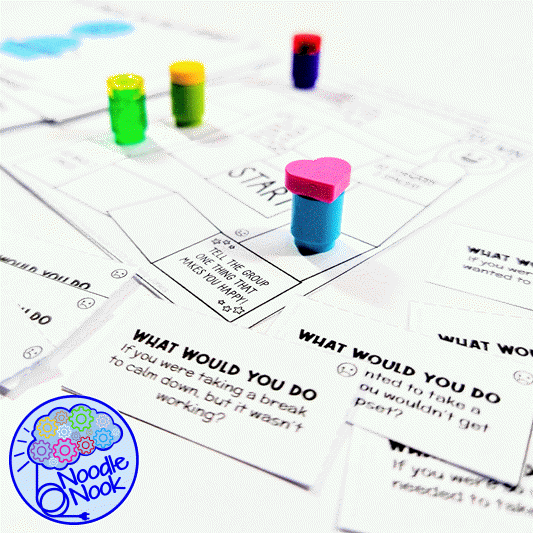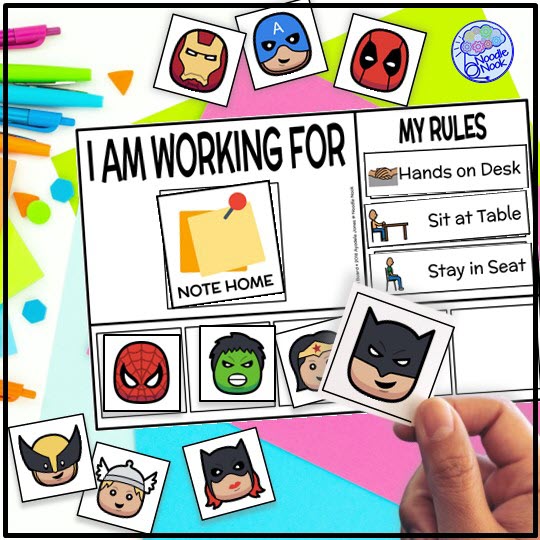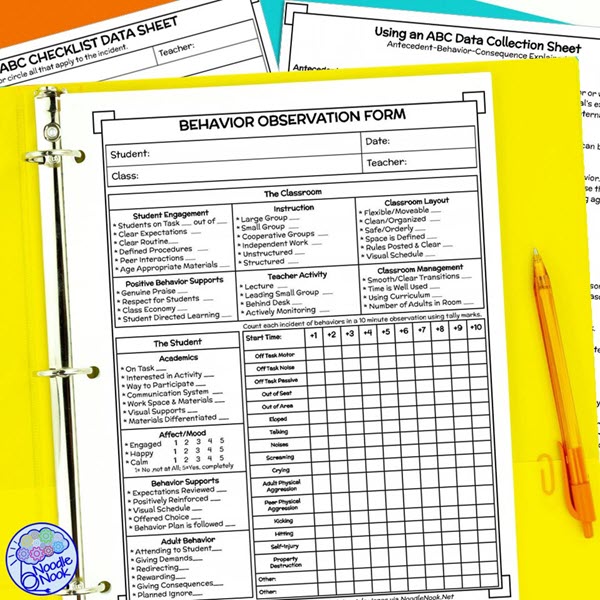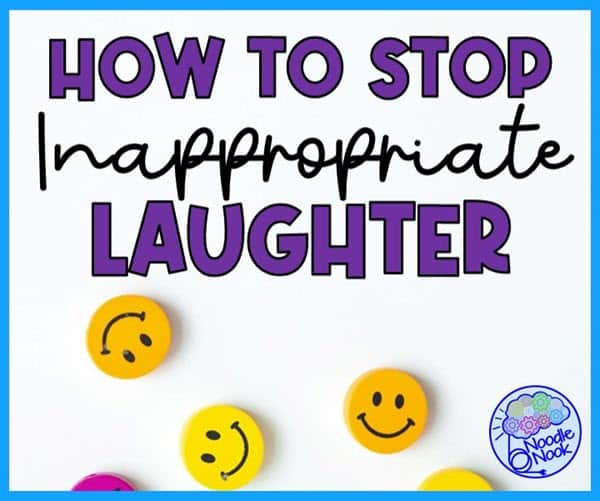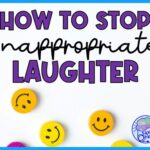The sound of a child laughing is like medicine! Right? Well… that may be true, but for a special ed teacher, the sound of a child endlessly laughing is confusing. What’s worse is that for a child with autism, that laughter could be indicative of needs that should be addressed. In other words, that laughter may be an alarm for help that’s needed. In this post, we’ll cover the 5 best tips on how to stop inappropriate laughter with autism in the classroom. Let’s dive in!
What is Inappropriate Laughter
First off, let’s define some terms. Inappropriate laughter in individuals with autism refers to instances of laughing that are not contextually appropriate or socially acceptable in a given situation. Sometimes a child is laughing when they shouldn’t be laughing, like during serious conversations, sad moments, or in response to situations that aren’t funny. Moreover, the laughter might be prolonged, excessive, or unrelated to the immediate social context.
Is Inappropriate Laughter Just in Autism?
Inappropriate laughter is often a symptom of autism spectrum disorder (ASD) and can be caused by various factors, including challenges in understanding social cues, difficulty interpreting emotions in others, sensory sensitivities, or difficulty expressing emotions appropriately. It is essential to understand that inappropriate laughter is not intentional or malicious; it is a manifestation of the individual’s unique neurological processing and social communication differences. That means, addressing this behavior requires understanding and patience. Most importantly, it requires appropriate support strategies tailored to the individual’s specific needs and preferences.
Why Do Kids with Autism Laugh Inappropriately?
Children with autism may laugh inappropriately due to various factors related to their neurodevelopmental condition. Some of the common reasons include:
- Social Interaction: Children with autism often struggle to interpret and respond to social cues, including nonverbal cues like facial expressions and body language. As a result, they may laugh at inappropriate times because they have difficulty grasping the emotional context of the situation.
- Medical Condition: Many children with autism may have co-existing medical conditions, such as pseudobulbar affect, which can manifest as uncontrollable laughter at inappropriate times.
- Positive Feelings: Laughing might be a way for autistic children to express positive emotions, even if the situation does not warrant it.
- Mental Health Conditions: Some children with autism may also have co-occurring mental health conditions, such as bipolar disorder, which can affect emotional regulation and lead to inappropriate emotional responses.
- Neurological Conditions: Neurological conditions, such as traumatic brain injury or hypothalamic hamartomas, can also contribute to pathological laughter in some autistic individuals.
Want to learn more about why kids with autism do that? Check out this helpful post HERE.
5 Teacher Tips to Stop Inappropriate Laughing
When a student with autism laughs at inappropriate times, it can be a problem. That’s even more true if it’s not an appropriate response to a situation. Unshared laughter can be alienating for a child and typical peers may struggle to develop social connections. When autistic stimming is laughter, then you may also want to address alternative ways to meet a student’s needs. Here are 5 tips on how to develop a more appropriate response.
- Social Skills Training: Implement social skills training programs specifically tailored to the needs of children with autism. These programs can teach them appropriate behaviors and responses in various social situations, reducing the occurrence of inappropriate laughter.
- Visual Supports: Use visual supports like social stories, picture schedules, or emotion cards to help autistic children better understand emotions and appropriate responses. Visual aids can enhance their comprehension of social cues and aid in managing their emotional responses.
- Sensory Strategies: Recognize and address sensory triggers that might be causing the inappropriate laughter. Offer sensory breaks or provide sensory tools like stress balls, fidget toys, or weighted blankets to help the child regulate their emotions and stay focused.
- Communication Support: Encourage the use of alternative communication methods, such as communication boards or augmentative and alternative communication (AAC) devices. Giving the child the means to express their feelings and needs effectively can reduce instances of inappropriate laughter caused by frustration or misunderstandings.
- Behavioral Interventions: Work with behavioral therapists or specialists trained in Applied Behavior Analysis (ABA) to develop personalized intervention plans. Behavior management techniques and positive reinforcement can help reduce and replace inappropriate laughing behaviors with more appropriate responses.
These five tips will help you address an inappropriate emotional response when a person laughs and shouldn’t be. It’s essential to determine the causes of inappropriate laughter as a pathway to a suitable replacement behavior.
Step-By-Step: How to Teach Appropriate Laughing
If you are in the classroom and struggling with how to teach appropriate laughter to a student, then this is your four-step plan. Remember, consistency matters! Do all the steps and be consistent in your approach.
Step 1: Understanding the Triggers
Observe and analyze the situations that trigger the inappropriate laughter in the student. Identify patterns, specific contexts, or stimuli that lead to this behavior. Understanding the triggers will help you develop targeted interventions.
Step 2: Social Skills Training
Provide the student with explicit social skills training. Use visual supports like social stories or emotion cards to help them recognize and understand appropriate emotional responses in various situations. Teach them how to identify social cues, such as facial expressions and body language, to gauge appropriate behavior.
Step 3: Reinforce Appropriate Responses
Implement positive reinforcement techniques to encourage the student to use appropriate responses instead of inappropriate laughter. Praise and reward them when they respond appropriately to social situations or display appropriate emotional reactions. Positive reinforcement can include verbal praise, small rewards, or preferred activities.
Step 4: Implement Coping Strategies
Teach the student coping strategies for managing overwhelming emotions or sensory experiences that may trigger inappropriate laughter. These strategies can include deep breathing exercises, taking sensory breaks, or using a designated safe space to calm down when feeling overwhelmed.
Optional Step: Collaborate with Specialists
If the inappropriate laughter persists despite the above steps, consider seeking support from specialists such as behavioral therapists, speech-language pathologists, or occupational therapists. They can offer additional insights and tailor intervention plans to address the student’s specific needs.
What Can You Do If Your Student Is Laughing During a Lesson
If you have a student who is inappropriately laughing during a lesson, it’s important to address the situation promptly and with sensitivity. Here are some steps you can take:
- Remain Calm and Observant: Stay composed and observe the situation to understand the context of the inappropriate laughter. Avoid reacting with frustration or annoyance, as this could escalate the situation or make the student feel uncomfortable.
- Remind with Non-Verbal Cues: Use non-verbal cues like facial expressions and gestures to signal to the student that their behavior is inappropriate. Maintain a calm and neutral facial expression to communicate that the laughter is not expected or appropriate during the lesson. This is not intended to shame or confront but to remind.
- Reiterate Expectations: Remind the student of the appropriate behavior expected during lessons. Use simple and clear language to reinforce classroom rules and expectations regarding appropriate reactions and behavior. I love a visual here! You can also use a gesture or other cue. Think of what will make the most sense for the student.
- Implement Positive Reinforcement: Encourage the student to display appropriate behavior by praising and positively reinforcing their appropriate responses during future lessons. This can include verbal praise, positive notes, or small rewards to recognize their efforts. Reference the behavior plan to be sure that you’re implementing interventions and consequences as intended.
- Provide a Private Moment: If possible, discreetly remove the student from the immediate learning environment and take them to a quiet and private space. This can help minimize distractions and provide an opportunity to address the behavior without drawing undue attention. It may also be that the student is challenged in the moment with the task at hand and this break can be in the calm down corner.
- Engage in Gentle Inquiry: Once you have a private moment with the student, gently inquire about their feelings or why they were laughing. Be patient and understanding while seeking to understand their perspective. They may not always have the ability to articulate their emotions or explain their behavior easily.
- Consider Sensory Factors: If sensory sensitivities are contributing to the inappropriate laughter, make appropriate adjustments in the learning environment. Provide sensory tools or breaks to help the student regulate their emotions and focus during lessons.
RECAP: How to Stop Inappropriate Laughter with Autism
Addressing inappropriate laughter in students with autism requires understanding, patience, and a multi-faceted approach. By providing social skills training, visual supports, sensory strategies, communication support, and behavioral interventions, teachers can help students develop appropriate social responses. Collaborating with specialists and involving parents can further enhance the impact of your interventions. You can do this, and your student’s will be thankful for your effort.
Inappropriate Laughter in Autism FAQ
You may still have a few lingering questions when it comes to laughing at inappropriate times.
- What is Inappropriate Laughter? Inappropriate laughter in individuals with autism refers to instances of laughing that are not contextually appropriate or socially acceptable in a given situation. It can manifest in various ways, such as uncontrolled laughter, nervous laughter, or unshared laughter.
- Why do Autistic People Laugh Inappropriately? Autistic individuals may laugh inappropriately due to various factors, including challenges in understanding social cues, sensory sensitivities, difficulty expressing emotions, and neurological conditions. It is essential to approach this behavior with understanding and patience.
- Can Gelastic Seizures Cause Inappropriate Laughter in Autism? Yes, gelastic seizures, which are characterized by uncontrollable laughter, can be a cause of inappropriate laughter in some individuals with autism.
- How can Family Members Help Address Inappropriate Laughter in Autism? Family members can play an important role in supporting individuals with autism by understanding the triggers and causes of the inappropriate laughter. Collaboration with teachers, therapists, and healthcare professionals can lead to more effective interventions.
- What are Typical Peers and their Role in Addressing Inappropriate Laughter? Typical peers refer to non-autistic children. They can contribute positively by demonstrating appropriate social responses and fostering inclusive and understanding environments.
- Are Funny Moments Related to Inappropriate Laughter in Autism? Yes, inappropriate laughter in autism may occur during what might be perceived as funny moments to others. The laughter is not always indicative of humor; it may be a manifestation of the individual’s unique emotional responses.
- How Can College Students with Autism Manage Inappropriate Laughter? College students with autism can benefit from implementing coping strategies, seeking support from counselors, and practicing self-help strategies to manage inappropriate laughter.
- Are Gut Problems Related to Inappropriate Laughter? Gut problems, such as gastrointestinal issues, can contribute to emotional regulation difficulties and may be linked to inappropriate laughter in some cases.
- What Causes Inappropriate Laughter in Autism? Inappropriate laughter in autism can have different causes, including sensory sensitivities, communication challenges, difficulty understanding social cues, and neurological conditions.
- Can Autistic Stimming Lead to Inappropriate Laughter? Yes, autistic stimming, which involves repetitive movements or behaviors, may be associated with inappropriate laughter in some instances.
- How can Parents of Autistic Children Address Inappropriate Laughter? Parents can seek medical diagnoses, collaborate with ABA professionals, and implement appropriate treatments to address inappropriate laughter in their autistic child.
- Is Inappropriate Laughter a Symptom of Mood Disorders? In some cases, inappropriate laughter may be linked to mood disorders, such as bipolar disorder, which affects emotional regulation.
- How can School Counselors Assist with Inappropriate Laughter in Autism? School counselors can offer support and guidance to both students and teachers in understanding and addressing inappropriate laughter in the school setting.
- Can Everyday Activities Trigger Inappropriate Laughter in Autism? Yes, everyday activities, especially those involving social interactions, can trigger inappropriate laughter in autistic individuals due to challenges in understanding appropriate responses.
- How Can Early Intervention Help Reduce Inappropriate Laughter in Autism? Early intervention can play a crucial role in providing support and implementing strategies to address inappropriate laughter and improve social communication skills.
- Are Tricyclic Antidepressants Used to Address Inappropriate Laughter in Autism? Tricyclic antidepressants are sometimes used to manage emotional regulation difficulties, which may be associated with inappropriate laughter in individuals with autism.
- What Are Some Self-Help Strategies for Managing Inappropriate Laughter? Self-help strategies, such as deep breathing exercises or sensory breaks, can be useful in helping individuals with autism regulate their emotions and reduce inappropriate laughter.
- Can Inappropriate Laughter Affect Interpersonal Relationships? Yes, inappropriate laughter can impact interpersonal relationships, as it may lead to misunderstandings or discomfort in social interactions.
- What Are Some Types of Self-Stimulation Related to Inappropriate Laughter? Self-stimulatory behavior, also known as stimming, can manifest in different ways. More typically, we see rocking or tapping, but stimming may sometimes be linked to inappropriate laughter in autism.
- Are External Stimuli a Cause of Inappropriate Laughter? Yes. External stimuli, such as sensory triggers, can contribute to inappropriate laughter in autistic individuals.
With these teacher tips, a fact-filled FAQ, and step-by-step guide to address inappropriate laughter, you should be on your way. I have faith in you… you can do this!

